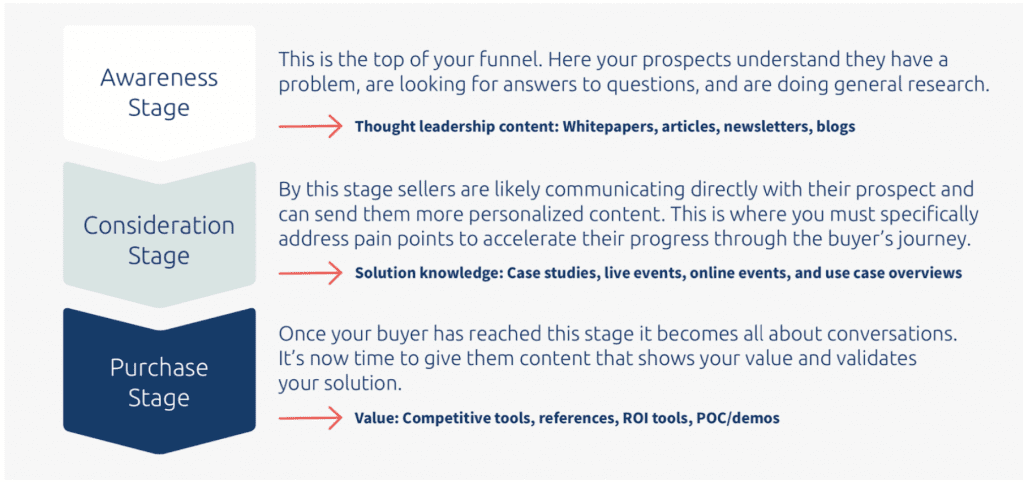Today’s buyers are in a class all their own: They’re independent, they do their research, and they demand detailed answers to their questions. Modern buyers don’t want to be sold at, they want to be talked to. They’re looking for content that’s pertinent to their situation, and they want to work with trusted advisors who are ready and willing to lead their prospects through every step of the purchasing process.
Before marketers can arm their sales team with content worthy of these informed buyers, marketing and sales teams require immediate and convenient access to assets, tools, and training––all within a single source of truth.
If you’re seeking answers for how to centralize your content and ensure your reps have everything they need to win deals, follow these steps.

Strive to simplify.
As early as 2016, marketers reported that 47% of buyers were likely to review three to five pieces of marketing content before even speaking to a sales rep (and we can only assume that number has risen in the last four years). Given the multitude of moving parts within marketing and sales departments, it’s now more vital than ever to simplify content production processes and align on providing a cohesive customer experience.
Tips on how to simplify:
First, develop a plan to consolidate your content across all departments. Identify all content storage locations, and then consider:
- Where can these materials be accessed and by who?
- Does your team have the means to establish a single, reliable repository for content and training?
- What tools are in place for notifying sellers and marketers if content is updated?
Depending on how you answer that second question, it may be useful to implement sales enablement best practices. A sales enablement solution provides a centralized platform for uploading, organizing, managing, and sharing content, including training materials. An advanced solution will also include interdepartmental communication capabilities and analytics — for example, data on content engagement and performance.
Prioritize alignment.
Buyers expect unique and highly customized buying experiences. And regardless of the challenges, sales reps will have to keep up. Given the heightened competition, well-laid sales plans should keep seller preparedness front and center.
These trends signal a need for tight sales and marketing alignment. Working in lockstep will save companies time and effort by keeping teams in sync when it comes to content creation, usage, and performance. Once the teams are properly aligned, companies can then implement an integrated strategy for managing, stockpiling, and disseminating all sales-related materials. As a result, marketers and sellers will be able to breathe easy knowing that the sales team will always be prepared for every customer conversation.
Tips on how to stay aligned:
When determining whether or not your sales reps have the knowledge and tools to make their next pitch, ask yourself:
- Do your reps have real-time access to content that helps answer questions from buyers?
- Is your sales team employing the right content at the right time?
- Is content mapped according to buyer persona and buying stage?

Once you’ve answered these questions, make a point to re-examine marketing and sales processes with an eye to fixing any gaps you may have identified.
Keep content current.
Sales reps are well aware of the expectations that fuel their results-driven fire. They likewise know that they need access to all content and training solutions necessary to provide their buyers with real value. Plus, reps need to find and deliver materials specifically curated for each individual buyer, making the job that much harder.
When a buyer requests a certain asset, be it a case study or contract, a seller needs a seamless, expedited process for creating, distributing, and monitoring that material. Moreover, all company content (educational or otherwise) should feature the most up-to-date, relevant, brand-compliant information available.
Tips on keeping content up-to-date:
The key here is to implement systems for complete content evaluation, including plans for tracking buyer and seller engagement as well as for assessing content performance overall.
Begin by considering:
- Is sales content current? Do you have a way to ensure that the assets that sales reps use have the latest messaging and design?
- How does your content change over time? What edits are your reps making to your assets once they get out in the field?
- How well does your content perform with buyers? How can you measure this performance in a quantifiable way?
Sales enablement solutions can handle content management and offer comparative views of different versions of specific assets, demonstrating how a piece of content is modified over time. These tools can give marketers a fuller understanding of how their content is performing and can likewise alert marketers as to whether or not the alterations made to an asset remain acceptable and on-brand. Content engagement capabilities provide insight into how buyers interact with your marketing materials with a variety of valuable KPI metrics, from website scroll depth, to click activity, pitch views, asset downloads, and more. This raw data can be used to glean insights, which can, in turn, inform the creation of new content campaigns.
In this new age of the educated buyer, marketers can gain a real advantage if they deploy the tools and techniques that make it easy to partner with their sales team in driving business growth together. Innovative technology, such as sales enablement solutions, make it possible to meet the demands of modern buyers. By integrating a holistic system for organizing, sharing, and analyzing all content, marketers will be better able to focus on creating content that sets their sales team up for success.
Thanks to Highspot for this guest post.



